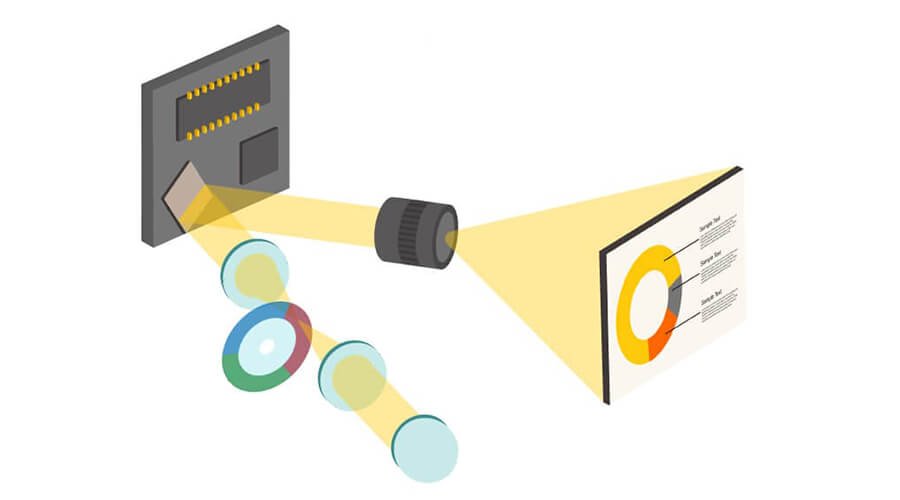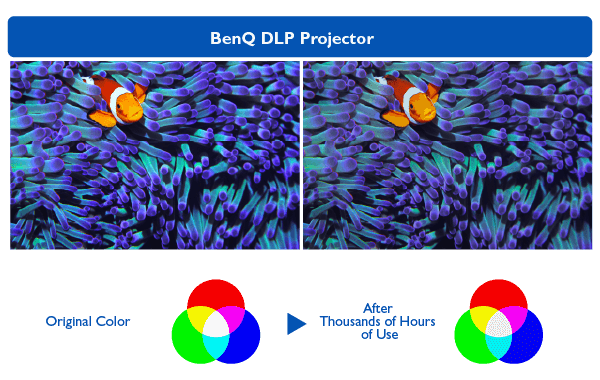DLP and 3LCD Projectors: What Each Type Means for Color Performance
- BenQ
- 2020-12-29
When purchasing a projector one of the most important things a consumer should be looking for is a projector that can produce life-like colors that not only bring an image to life but also enhance the viewing experience. But with so many options available on the market, how is a consumer to know which type of projector will deliver this kind of color performance? Which one of the two main types of projectors, a DLP or an LCD (particularly a 3LCD) projector, will provide them with the colors they expect? The following article will help introduce both types of projectors to users confused over their differences, including the engineering principles behind each projector type and how they relate to their color performance.
What is a DLP projector? What is a 3LCD projector?
A Digital Light Processing, or DLP, projector is a projector that produces images using a Digital Micromirror Device, or DMD, which is a semiconductor chip composed of microscopically small mirrors. The way a DLP projector works is light for each primary color (via either a color wheel or from individually colored LEDs or lasers) is directed onto the DMD chip which then reflects the light through the projector’s lens onto the projection screen. During this process each microscopic mirror (which may number in the millions) located on the DMD chip angles itself to create a version of the respective primary color for the image’s pixels. The same process is then repeated for each successive primary color, which when done at an ultra-fast rate creates the full image that represents a frame from the video.

A 3LCD projector, on the other hand, is a projector that uses three transparent LCD panels, one for each primary color (red, green, and blue), to create its images. To project an image, each LCD displays their respective primary color’s share of the overall image which the projector’s light then passes through successively. The resulting light from each LCD is then re-composed before being directed through the projector’s lens to create the complete image that appears on the projection screen.

What is a DLP projector? What is a 3LCD projector?
How then do the engineering principles described above affect the performance of each type of projector? What positives do each type of projector bring to the discussion regarding color performance?
For DLP projectors the main advantage of its design is in how it prevents color deterioration. This is because of the fact that the main imaging component for a DLP projector is essentially a mirror, which as a reflective surface absorbs close to none of the light and resulting heat. This in turn prevents decay of the main imaging component, thereby ensuring that the colors it produces are steady and reliable throughout its entire lifespan with little to no degradation over time. In comparison, because the 3LCD projectors utilize LCD panels as their main imaging component through which the light passes through, the LCDs eventually deteriorate, many times at different rates, as a result of the light absorption by their liquid-crystals, leading to faded colors and/or a tint to the image.
What the discussion above also touches on is another one of the advantages that a DLP projector brings, which is its overall reliability. Because of the mechanics described above, the internal components of a DLP projector tend to have a longer lifespan than that of a 3LCD projector whose LCD panels tend to degrade quicker over time due to the effects of light and heat absorption. This difference is further exacerbated by the fact that the internal components of a DLP projector works within a fully enclosed space that prevents the intrusion of dust and dirt, while 3LCD projectors require constant airflow to cool its components which bring particles that further accelerate wear and tear.


On the flip side, the main advantage of a 3LCD projector is its higher color brightness levels in comparison to similarly priced DLP projectors. This advantage arises from the fact that the projected image from a 3LCD projector is produced by the simultaneous combination of the colors from the three LCDs, which means a greater amount of total color/light in each frame. The image from its main DLP projector counterpart, a single-DLP projector, on the other hand, is a result of the projection of each primary color in rapid succession. This means that at any given moment the light from a single DLP projector is only a fraction of the total light in each frame. There are DLP projectors on the market which are able to resolve this issue, such as projectors with a 3-DLP system, but in general these projectors tend to be costlier and thus outside of the budget of the average buyer. This means that for comparable models at the same price point, a 3LCD projector tends to have higher color brightness levels than its DLP counterpart. This is a compelling advantage given that many projectors may be used in settings where the ambient light cannot be controlled.
Another advantage to using the 3LCD projector is that its imaging does not feature the “color breaking” phenomenon that some DLP projectors produce. “Color breaking” refers to the slight misalignment of the primary colors at the edge of each image which causes the edges to reveal an additional amount of color that is noticeable at close distances by some viewers. This misalignment is due to the previously described mechanics that an DLP projector employs in which a frame of video from the projector is actually a result of successive primary color images projected at an ultra-fast rate. Since the engineering behind 3LCD projectors utilize a different set of mechanics, their images do not feature such an issue.
BenQ: Your Brand for DLP Projectors
As the world’s #1 brand for DLP projectors for ten consecutive years, BenQ has a wealth of experience from which we draw upon when designing each of our projectors with the ultimate goal of building upon the benefits that DLP projectors bring to the table, from the stability of their color performance as a result of a lack of color deterioration, to the cost-saving effects of their longer lifespan. With a vast range of lines including projectors for small and medium-sized businesses, corporate clients, schools and academic institutions, exhibition spaces, and simulation technology, BenQ has made sure that all types of projection needs are covered by our DLP projectors.
You May Also Like
-
Unpublished: {/content/newb2b/en-us/resource/trends/5-reasons-to-choose-dlp-classroom-projectors}
-
Trends & Knowledge
DLP or 3LCD Projectors for Large Venues? The Difference is Dustproof Technology
BenQ is the world’s #1 DLP projector manufacturer. To achieve further advances in projector image quality, stability, and reliability, BenQ has been focusing on dustproof technology.
2019.07.02 -
Unpublished: {/content/newb2b/en-us/resource/trends/dlp-laser-dustproof-projectors}